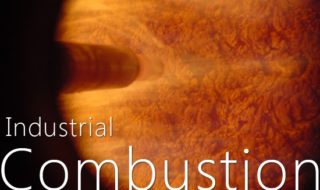-
Industrial Combustion Journal: Blast from the past
Date posted:
-
-
-
Post Author
Lucy StrakerIFRF Administration & Communication Coordinator
-

This week our #BlastFromThePast comes from 2007 and is L. Patrignani’s paper on “Numerical studies of the integration of a Trapped Vortex Combustor into traditional combustion chambers”. The abstract is below and you can download the paper here.
Abstract:
“Combustion technology based on premixing reactants with combustion products has demonstrated that efficiency and emissions may be improved for some industrial ap-plications, notably furnace burners.
Work in progress in the US and EU started with applications to gas turbines (GT); the main advantage in this case is lower emissions, especially NOX, and better temperature uniformity at the combustor exit, possibly leading to better pattern factor. For sta-tionary combustion, for example furnaces, the Trapped Vortex Combustor (TVC) may be considered a very promising technology, again to reduce emissions and especially to ensure temperature is uniform in the exhaust products. This last is a key feature in certain types of heat treatment, for instance in steel rolling mills.
The TVC concept, as conceived for GTs, was introduced in 1995 by Katta and Roquemore [2][3][4] and was based on fluid dynamic studies by Little and Whipkey [5] on drag reduction on bluff bodies. It was configured to mix air, fuel and hot prod-ucts at turbulent scales fine enough that the combustion mode could become in fact “flameless”, or close to “flameless”. Since the flameless strategy requires recirculation of hot combustion products within the combustion chamber, it seems reasonable and feasible to achieve a (mostly) flameless combustion at high flow rate regimes by means of trapping toroidal vortices in suitable cavities. As already known, a vortex ensures a high recirculation factor, Kv, between hot combustion products and reactants, and, ultimately, flame stability. The flameless regime is considered achievable if Kv > 3.5 – 4 (this means up to 75 – 80 % of the gas in the combustion chamber is made of hot combustion products). In a TVC, Kv is about 18-22 (95 % of recirculation means Kv = 20). If this situation is realized, the immediate advantage will be a much lower pressure drop in GT applications, a reduced or a totally suppressed need for flame anchoring, and lowered NOx emissions.
This paper focuses on numerical studies performed on novel GT-derived TVC geome-tries which can successfully deal with part, at least, of the requirements mentioned above. The ultimate goal is to design a TVC that can “easily” replace a traditional pilot flame-based GT combustor as well as industrial burners. The geometries presented here are particular, in that they are designed to fit inside a pre-existing combustor chamber and were arrived at using the same reference volume. The aim, in this case, was to provide a novel class of TVC capable of operating at up to 30 atm, using liquid or gaseous fuels; however, results can be generalised to those burners where exhaust temperature uniformity is important.
This work is part of the work performed with AVIO of Italy for the EU Project “TLC” (“Toward Lean Combustion”), started in March 2005 and where these authors were team members.”
